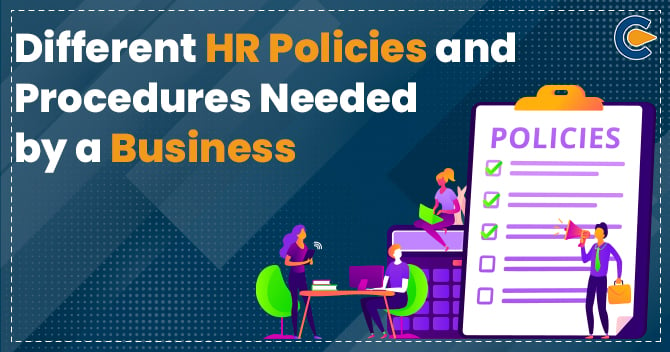The purpose of the HR Templates is to provide your HR Team with the starting block they must excellent working environment at the Company premises. The HR Templates include many policy documents, forms & agreements. This blog explains the Different HR Policies and procedures a business needs.
What are HR Policies?
Human Resource strategies are also defined as the set of norms & concepts of behaviour which regulate an organisation’s interaction with its employees. An HR policy proposal sets instructions for a broad range of employment connections inside the business. The primary purpose and relevance of HR rules are self-evident. All firms must need the HR Policies and Procedures to promote normal behaviour and employee relations equality.
HR Policies and Procedures under HR Templates
HR Department Policies & Procedures are critical in SMEs because they give an outline, uniformity, management, justice, and rationality. Moreover, they guarantee that employment laws are followed and that their employees know their obligations and goals. Here are some essential HR Policies and Procedures mentioned and defined:-
- Code of Conduct: This policy is the company’s policies, consisting of its mission, vision & ethics. This is created to inform employees about the HR policies and procedures for maintaining discipline and behaviours at the workplace. The code of conduct is the type of HR policy containing the company’s rules that employees need to adhere to. It includes-
- Dress code,
- Electronic usage policy,
- Media policy,
- Equal rights for all,
- Conflict of interest,
- Proper work environment,
This policy also includes the rules & penalties in case an employee breaches and violates the code of conduct.
- Employee Information Forms: In India, it is crucial to file proper documents of the employee that work in the company. The employee’s contract Acts as the umbrella covering a list of agreements and HR policies.
According to India’s employment laws, this is essential to file proper documents of the employees to ensure appropriate navigation of the complex & diverse employment framework.
- Leave Policy: According to requirements, all companies should have a good leave policy to provide clarity of leaves they would be entitled to take in year. The HR policy should include a proper bifurcation of the leaves into sick, paid, casual, etc. it must also mention public holidays.
- Recruitment Policy: This policy usually identifies candidate selection criteria and outlines the new employee onboarding process. If you are an employee referral program, include it in the recruitment policy.
- Employee Evaluation Forms: This evaluation policy communicates to the employees how their work is graded transparently & performance is rewarded. This ensures that all employees are treated honestly and can be great inspirational tools.
- HR Surveys:
- Maternity & Paternity Leave Policy: All organisations with more than ten workers must follow the maternity benefits (amendment) Act, 2017[1]. Maternity Act is perhaps one of the prevalent HR policies in India. It outlines the advantages and leaves a pregnant woman who has worked in an organisation for 80 days entitled to. As per this Act, this policy must include at least a 26-week paid leave for women for the first two children & 12 weeks of leave.
- Termination Policy: On the other hand, this policy explains how the employee is expected to provide their resignation & the amount of notice needed. That may also list the employee actions that may result in termination.
- Health & Safety Policy: The health & safety policy outlines the responsibilities and processes of all employees to keep the workplace safe.
- Working hours & overtime policy: This policy states how flexible the work hours are when breaks shall be taken and for how long, how to clock out & in. and explain how overtime work is handled & compensated.
How to Write HR Policies?
In case your HR team has to draft an HR policy, certain precautions have to be taken because you want the botched official document of your organisation, which lays down important rules & regulations for all employees.
The unclear document riddled with errors shall eventually make the HR team look bad in front of every employee, especially the leadership team. Here are essential precautions which help you write correct HR policies and procedures:-
Precaution 1: Get the HR policies title spot on- All HR policy documents have a title that summarises the document’s contents in a straightforward manner. Before the HR team even begins drafting the contents of the policy, they should find a suitable title because it sets the tone and the context for the rest of the HR procedures. HR policy ties various processes together; an apt policy title shall assist employees in identifying & referring to particular procedures. Your policy title needs to be able to answer the basic questions such as whether the title explains the entire policy, how it can assist the reader, and if employees, old/new, can comprehend the title.
Precaution 2: know why we need HR policies- Understanding the actual motive behind writing HR policies is essential. In another way, what do you want to achieve when writing HR policy?
They are addressing the doubts & questions of employees without any problems. They shall be able to see the policy documents and specific policy points. Hence, this is crucial to outline the motives of the company and the HR team.
Precaution 3: keep this crisp & clear- When you create the HR policies document, you shall be clear about the language. Can the reader understand whatever you mentioned in the polices document entirely? If not, then the team has to go back to the drawing board & simplify the language. This should be simple, clear, and concise. All processes need to be explained in elementary style.
Precaution 4: Sound as the alarm in your HR policies wordings- HR policy should apply to every employee, even to the leadership team. And that is why the policy statement needs to underline every rule & regulation. In addition, you should follow them up with repercussions if rules are not obeyed or employees try to circumvent them same.
Precaution 5: Uncomplicated the complicated- HR policy can be downright tricky & confusing to follow. That is why the team should be sure that the policies are written correctly. Also, all little policies and rules within the policy must be clearly defined. For instance, you need to provide references for approaches which are not clear. Your readers will try to understand the meaning of every tiny piece of information in the HR policy.
Precaution 6: Chalk out the outline- The HR policies for the company need to be clearly outlined. Moreover, this means that the specific procedures and guidelines should be broken down into steps so that call employees can understand and follow them.
Precaution 7: The final steps- Now that HR policies have finally taken shape, we should not pull the trigger & finalise it no matter how desperately we need it. Since this is the final draft, you should read again your policies and then re-read the policies to oust & rectify any errors. You need to provide clarity on all small information and take care of any omissions before the final draft is finalised.
Precaution 8: Get additional help- The HR policies written by you or the HR team under your supervision might still have many errors, which may go unnoticed. So, get help from professionals for additional comments and feedback. This process will help you fine-tune your HR policy.
Precaution 9: Testing it on others- You must build confidence before submitting the organisation’s final HR policy. That is why this is a great idea to share it with other members of the HR team & senior executives from other departments.
Precaution 10: The policy needs to adapt- The underlying fact about official documents like the HR policies is that they are bound to change. Business decisions, crises like the ongoing pandemic, work trends, and the market will influence HR policies and procedures to some degree.
Conclusion
The HR (Human Resource) department is solely responsible for ensuring that the company’s policies adhere to all applicable local, state, and federal regulations. HR staff must also be aware of these rules and follow the proper protocols. Given the complexity of Indian corporate law, adequate care should be given when developing the company’s policies.










